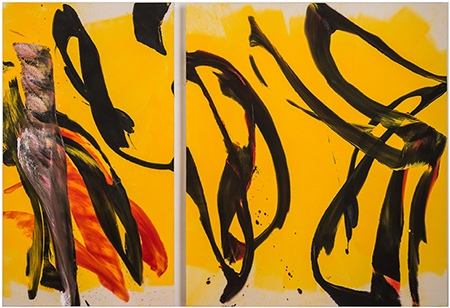
Continuing through January 12, 2024
Ed Moses (1926-2018) made no pretense of depicting figures of any kind in his work. While his style is described as Abstract Expressionism combined with Pop Art, his MO is more about the paint itself, his gestures in applying the paint, manipulating the paint in surprising ways, and even the tools he uses to apply the paint — including squeegees, mops, squeeze bottles, house painters’ implements and hoses.
The foundations of his painting techniques and expressions were his spiritual belief in Tibetan Buddhism, his desire to be in tune with the universe rather than “in control” while working, to have his viewers feel a range of sensations, thoughts and emotions, and his penchant to mine his primitive unconscious while working.
His artist son Andy Moses (whose paintings are also abstract, but more directly connected to the Light and Space aesthetic) explains, “He tapped into similar aspects that humans probably tapped into 30 or 40 thousand years ago when they were making cave paintings.” Ed Moses referred to himself as a shaman or magic man, as one who shakes the rattles in the tribe.
As a self-described action painter, Moses was versatile and nuanced in his approach to his work, continually seeking new techniques of paint application, accepting mistakes as part of his process, and never content with any one signature style that might define him.
The nearly four dozen paintings that comprise “Emptiness is Form,” all from a private collection and thus seldom seen by the public, makes for a fresh dive into his fluid, expressive painting style, dark inky lines and broad swatches of paint meandering across the canvasses.
“Untitled” (1985) is a diagonal grid painting populated by deep reds and greens and muted squiggly lines, inspired by his interest in woven Navaho rugs. Moses, with his spiritual proclivities, acknowledged his affinity for indigenous creations.
In “Boqe” (2002), many dark-hued, striated biomorphic shapes, are set against a deep red background. They all seem to explode outwards toward the viewer. Whether this effect occurred intentionally during the painting process, or by accident, which Moses certainly would have welcomed, is beside the point.
In “Chuk” (2006), “VGA” (2006), and “Walt” (2007) broad loopy lines (Moses called them “loopdeloops”) are deliberately and powerfully applied. In the 10-foot wide “Air #2 & #3” (2014), broad fluid dark brown lines sweep across a deep yellow background, and they carry us to new, expansive worlds.
If Moses was guiding us toward an understanding of his work, he might refer to his broad splashes of paint and bold lines as magical elements. Some function as mandalas, which are used by spiritual practitioners to focus attention. Among his spiritually inclined paintings are “Untitled Pink” (1994), composed of loosely applied paint that the artist manipulated while still wet so as to involve elements of chance. There is also “Moo Verk” (2002) with large segments of thick dark paint punctuated by silver paint, creating a sense of mystery.
The “Craguelures” paintings were created toward the end of Moses’ life, and far from being frail rehashes of what he’d painted in his prime, they reach beyond previous efforts to bring paint to new levels. After completing the application of paint — as with “Spiro-Fork #1” (2011-2012) — he would literally grab the canvas so that the paint would split, peel, seize up and crack. The resulting irregular patterns are suggestive of primitive life forms, flowers and even elements from worlds beyond ours. The “Craguelures” pieces could be called the apotheosis or culmination of Moses’s career, as these are as much energetic, spiritual experiences for us as they are completed paintings — aspects of the work that the artist is likely applauding from wherever he is in the universe.
As Moses explored the many possibilities of handling paint and ways to apply it to canvases, his work as a painter became his method of understanding the universe, its energy and spirituality. The canvas became for him a locus of wide-ranging ideas, including fields of energy, electromagnetic waves, and the Asian concept of Chi, or the life force that flows through all of us and our environment.
